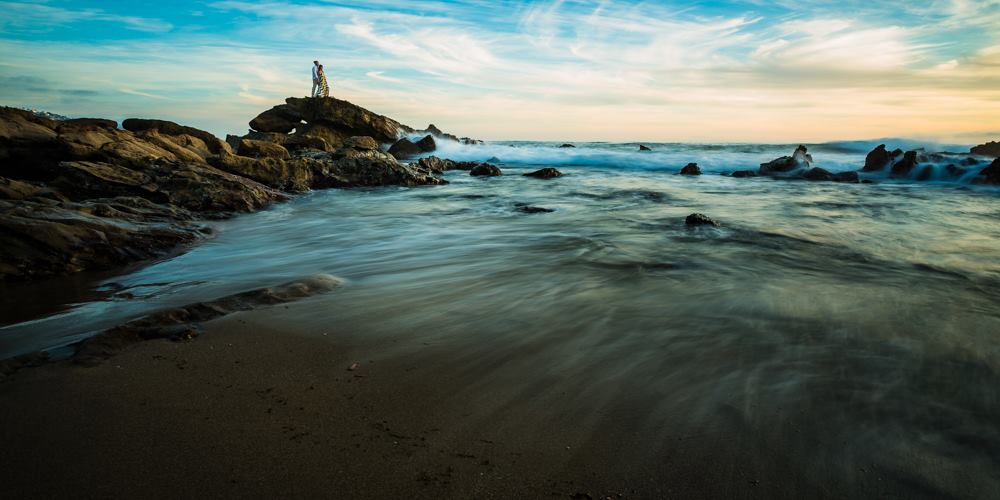One often overlooked yet powerful tool in a photographer’s arsenal is the Neutral Density (ND) filter. ND filters are most commonly used for landscape photographs in order to reduce the amount of light entering the camera lens without affecting the color of the image. So why would you use it for portraits? This versatile accessory can transform your portrait photography by allowing for greater control over exposure and depth of field, even in challenging lighting conditions. In this article, we will explore 3 ways to use ND filters for portraits and give our recommendations on which ND filters to use.
ND Filter Portraits With Long Exposure Photography
- Camera Settings: Canon 5D Mark III + Canon 17-40mm, 1 second, f/9, ISO 50
- Lighting: Tiffen 1.5 Water White
- SLRL Lightroom Preset: 11g HDR Natural Color
Usually, photographing a shutter drag in broad daylight requires an extremely high f-stop and a slow shutter speed. Having a 5-stop ND filter allows us to get much more movement out of the water by slowing down our shutter to 1 second and maximizing our dynamic range at a low ISO of 50. With just one click, we were able to enhance the colors and bring up the shadows using our Lightroom Presets.
ND Filter Portraits for Maximizing Dynamic Range
Shooting at the lowest possible native ISO allows us to retain all of the highlights and shadows but in doing so you are using the ambient light as your main light. While we are maximizing our dynamic range our subjects are pretty much in the dark and therefore we need to compensate by adjusting aperture and exposure in turn.

- Camera Settings: Canon 5D Mark III + Sigma Art 24mm, 2″, f/16, ISO 50
- Lighting: Tiffen 1.5 Water White, sprayed lens with filtered water and took a shot with 1 Canon 600EXRT pointed directly at camera.
- SLRL Lightroom Preset: 11g HDR Natural Color
We bumped our aperture to f/16 and strobed directly at our lens to create these beads of light. Why such a high f-stop? The lower the f-stop the larger the bokeh-balls would have been. To capture movement in the water and retain the colors in the sky we used an 4-stop Tiffen ND filter to help us achieve this picture perfect formula.

- Camera Settings: Canon 5D Mark III + Canon 90mm TS-E @ 1/200th, f/4 and ISO 100
- Lighting: 3 Canon 600EX‑RT’s, Tiffen 1.2 Digital HT ND
- SLRL Lightroom Preset: 11d. Black Crush
This image was shot intentionally underexposed to create a more dramatic flash to ambient balance. In noon day sun we had to use a Tiffen ND to keep our aperture at f/4 while using flash to chisel out our subjects. This way we didn’t need to stop down to f/16 and compensate with an increase in ISO. The flashes were composited out in post. Check out this one minute video on how to maximize your dynamic range:
ND Filter Portraits Using Flash Without HSS
Using HSS may be a simple switch of a function, but there are definite cons when it comes to consistency. Light output differs as each shot is fired using HSS mode on flashes, making it hard to replicate the same power in each shot. Recycle times, especially when shooting in broad daylight trying to overpower the sun, are slow and will delay the shooting process. If we want to maintain a shallow DOF, using an ND filter for our portraits in the sun in conjunction with a strobes keeps us at a 1/200th sync speed.

Camera Settings: Canon 5D Mark III + Sigma Art 35mm @ 1/200th, f/1.4 and ISO 50
Lighting: 3 Canon 600EX‑RT’s, Tiffen 1.2 Digital HT ND
SLRL Lightroom Preset: 11b. Standard Color
Notice that we are at f/1.4 in this image meaning that in order to compensate we would have to adjust our shutter speed. Instead of using HSS we We were able to use three flashes to overpower the sunlight in this image below.

- Camera Settings: Canon 5D Mark III + Canon 90mm TS-E @ 1/200th, f/2.8 and ISO 50
- Lighting: Solid ND 1.2 Filter +4 Stop held over lens for sync capability, Profoto B2 w/ reflector off to camera right
- SLRL Lightroom Preset: 11d. Black Crush
For this shot we placed the couple directly over the brightest area of highlights in the water to naturally draw attention into their faces. Ambient exposure was left brighter to have a slightly more “natural” feel.
Gear for ND Filter Portraits
We discuss in our Lighting 201 workshop in SLR Lounge Premium why quality matters for ND filters. Since you are placing an object in front of your glass, you need to ensure that it won’t reduce the overall quality of your image.
Cheaper ND filters tend to have tint defects that can hamper the color retention of the image. Here are our favorites:
- Tiffen 1.5 Water White IR ND (for IR reduction)
- Tiffen 1.2 Digital HT ND (for color transmission)
- Tiffen Pro 100 Series Starter Kit **

Tiffen’s Oscar-award winning ND’s are a must have for any strobe user because of one reason: reliability. At each price point, they offer an ND filter that performs as good or even better than competing/more expensive filters.
Stop letting light stop you from creating your next masterpiece, find ways to work around it and use its power to your advantage. For more lighting tips & tricks check out Lighting 101 & Lighting 201 to make your gear work for you. Upgrade to Premium now to stream both workshops!














